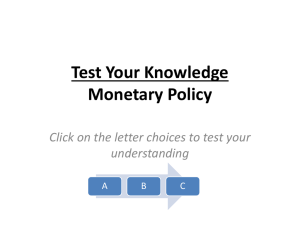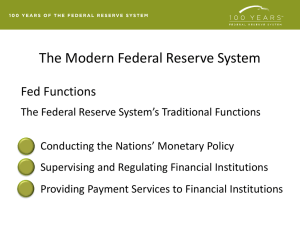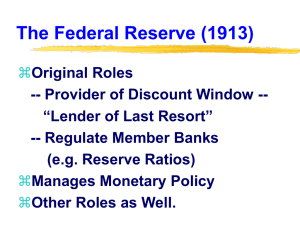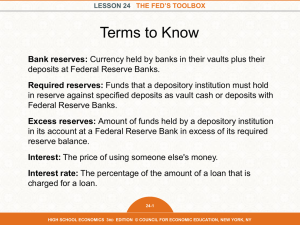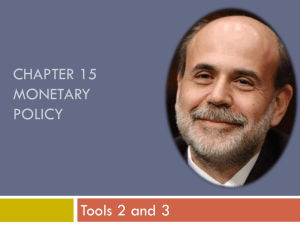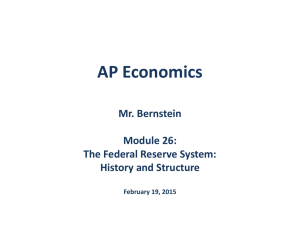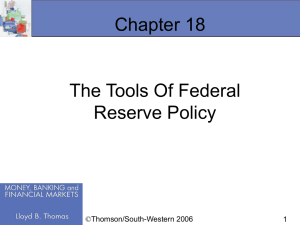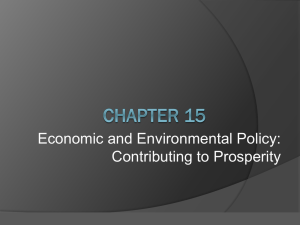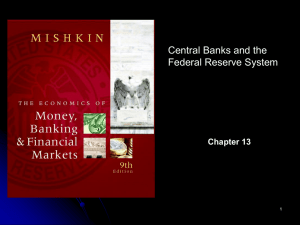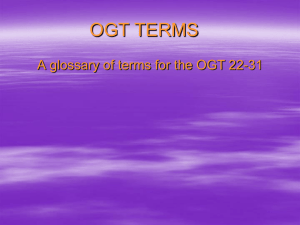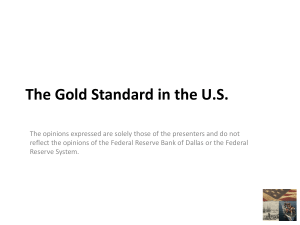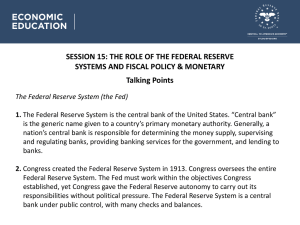Federal Reserve System and Monetary Policy NOTES
advertisement
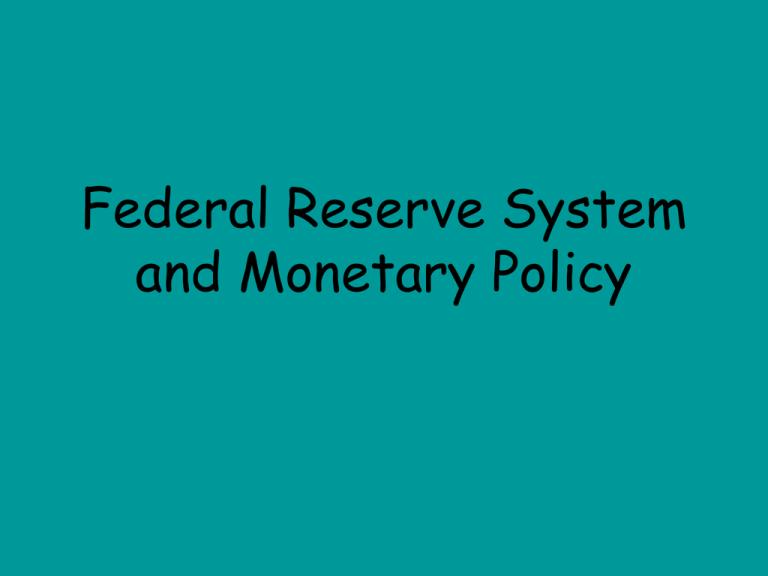
Federal Reserve System and Monetary Policy • The amount of _______ in an economy MONEY is important because it affects the level of __________ in a country. SPENDING INFLATION • Too much spending can cause ________ while too little spending can cause UNEMPLOYMENT and declining levels of ____________ PRODUCTION _________. • In the United States, Congress has assigned the responsibility for controlling the money supply to the _______ ________ FEDERAL ________ RESERVE SYSTEM FED has • The Federal Reserve System or “____” functioned as the central bank of the United States since ____. 1913 • It consists of a ___-member Board of 7 Governors in Washington, D.C., plus ___ 12 regional banks throughout the country. Our Federal Reserve Bank is in Dallas. Ben Bernanke, Chairmen of the Federal Reserve Federal Reserve Bank of Dallas, Houston Branch How do we print money? • The Federal Reserve System is designed NON-POLITICAL as possible. to be as ____________ • We achieve this by… – The Governors serve staggered 14 year terms – The Fed does not rely on appropriations from congress (that is money to run it) – The governors’ terms end in January of even numbered years, so one president does not get to appoint many governors A Central Bank • As a central bank, the Fed manages the MONEY _______ SUPPLY ______ by influencing the lending activity of commercial banks and other financial institutions. • But the major part of its direct influence comes about through its relationship and dealings with COMMERCIAL ______, BANKS _________ from which the effects spill over to the financial WHOLE system as a ______. • The deliberate actions of the Federal Reserve System to EXPAND ______ or _______ CONTRACT the money supply are called ________ MONETARY POLICY ______. They purpose of monetary policy is to maintain the trend of ECONOMIC _______, OUTPUT EMPLOYMENT and _______ __________ _______ at desired levels. The Board PRICES of Governors and twelve heads of the 8 times regional banks regularly meet ___ a year to decide on Federal Reserve monetary policy. Expansionary or Contractionary • A policy of Fed designed to expand the growth of money and credit in the economy is EXPANSIONARY (or loose) known as an _____________ monetary policy. • A policy to restrict the growth of money and credit in the economy is known as a _______________ CONTRACTIONARY (or _____) TIGHT monetary policy. MONEY can cause • The creation of too much ______ _________, INFLATION and the creation of too little RECESSION money can cause a ___________. What is Inflation or Deflation? • The Fed has three primary tools with which to carry out monetary policy. These are: OPEN ________ MARKET __________, OPERATIONS – (1) _____ RESERVE ___________, REQUIRMENT – (2) ________ DISCOUNT _____. RATE – and (3) the _________ Open Market Operations • Open market operations refer to the Fed’s buying SECURITIES (like and selling of U.S. government __________ savings bonds) in order to ____ ADD (+) or to SUBTRACT (-) from the reserves of the nation’s ________ commercial banking system. • Government securities, such as U.S. Treasury _____, BILLS ______, NOTES and ______, BONDS are issued by the U.S. Treasury in return for money borrowed from individuals and businesses in order to finance government spending. • If the Federal Reserve wants to put BUYS some money into the economy, it _____ of these government securities by writing a check to itself. If for $10,000 worth instance, the Fed buys _______ of government with such a check, it $10,000 creates the _______ used to pay them. • The sellers are not $10,000 richer, since they no longer own the securities, but the money supply grows because NEW ______ MONEY in there is $10,000 of ____ the economy. • If the Fed wants to purse a CONTRACTIONARY ____________ monetary policy, it ______ SELLS some of the government securities it owns. • The money that is paid to the Federal Reserve for these securities is REMOVED ________ from the economy, so the money supply _______. SHRINKS • Open Market Operations are the most frequent used _____ TOOL of the monetary policy Reserve Requirement • A second important tool of monetary RESERVE policy consists of ________ REQUIREMENTS for bank deposits. The ____________ Federal Reserve requires that banks FRACTION of keep as reserves a certain ________ the deposits they hold. These reserves must be kept as balances at Federal Reserve banks or as ______ the banks CASH VAULT CASH have on hand (i.e., ______ ______). Banks that fail to meet their reserves are subject to monetary penalties. LENT These reserves cannot be _______ to borrowers. Reserve Requirements • If the Fed wants to pursue a CONTRACTIONARY monetary policy, it _____________ can ______ reserve requirements, RAISE thereby restricting the amount of funds bank can lend. • If the Fed wants to pursue an EXPANSIONARY ______________ monetary policy, it LOWER can ________ reserve requirements. • Let’s say you deposit ______ $10,000 at your local bank and the reserve requirement on deposits is ____ percent. This 15 means that your bank would have to $1,500 keep ______ on reserve at the Fed (.15 $1,500 x $10,000 = _______). It could lend the other $8,500 _____ to borrowers. If the Fed were to ______ the reserve LOWER requirement to 10 ___ percent, then the bank could lend $500 ____ more of your $9,000 $10,000 deposit or a total of ______. Such an expansion of lending causes the money supply in the economy to INCREASE _________. • However, if the Fed were to _______ RAISE 20 its reserve requirements to ___ percent, the bank could lend only $8000 _____ of your $10,000 deposit, thus curbing the possible increase in the money supply. Changes in reserve requirements can be a very powerful _____ TOOL of monetary policy but this tool is used infrequently precisely because it is so powerful. Most often, the Fed desires to make GRADUAL ________ or minor changes in policy, aims for which changes in reserve requirement are ____ suitable. NOT Discount Rate DISCOUNT RATE , the third • The __________ _____ tool of monetary policy, is the interest rate the Federal Reserve charges BANKS that borrow money. ______ • If a bank borrows from the Federal Reserve, the reserves lent to the bank CREATED are _________ by the Fed. INCREASES the amount of • This process _________ money and credit in the economy. • The Federal Reserve does not automatically allow a bank to borrow from it whenever the bank wants to. REFUSE The Fed can _______ such a loan. LOW and the • IF the discount rate is _____ Fed does not discourage banks form borrowing form it, the Federal Reserve EXPANSIONARY will foster an ______________ monetary policy. HIGH and the • IF the discount rate is _____ Fed discourages banks from borrowing from it, the Federal Reserve will foster TIGHT a ________ monetary policy. • This discount rate is probably the least 3 principles of strong of the ___ monetary policy, but the Federal Reserve does use a change in it to TIGHTENING indicate an overall ____________ or LOOSENING _____________ of monetary policy
